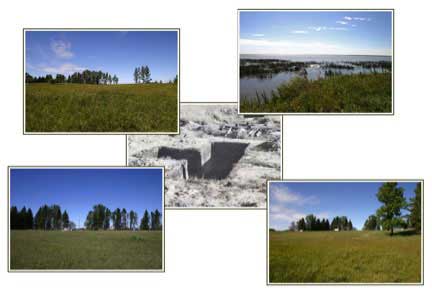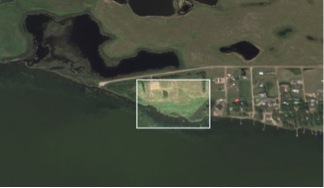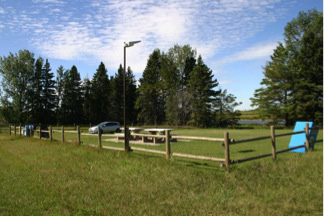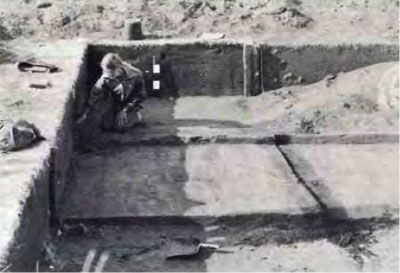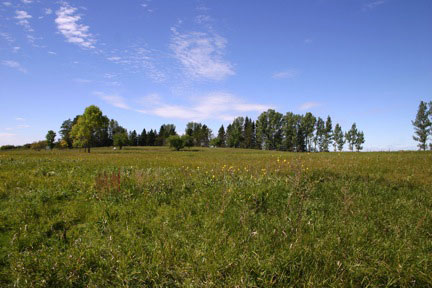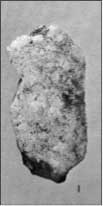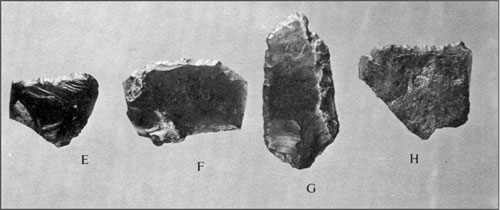
1. Cherry
Point
Cherry Point is a peninsula on the north shore of Oak Lake named for
the chokecherries that can still be found on the wooded shoreline.
Today it is a quiet green space alongside a cottage development. Some
interpretive signs, a few benches, and a small parking lot welcome the
visitor. Little in the landscape remains to remind a visitor of the
significance of the site.

2. The
Times
From 1000 to 2000 years ago the location was a seasonal camp and bison
kill site for hunter-gatherers known as the McKean People. Elsewhere in
North America during those times Inca, Mayan and Aztec civilizations of
Central and South America had erected large cities. The Anasazi,
or
Ancient Pueblo Peoples were building cliff dwellings in Utah, Colorado,
Arizona and New Mexico. To the east the Iroquois and Huron
civilizations flourished in their large villages.
In Europe both the Greek and Roman civilizations blossomed, peaked, and
declined.
These north-central plains were one spot in North America were
agriculture hadn’t been established. The climate wasn’t suitable and
the huge bison herds provided nearly everything the people needed.
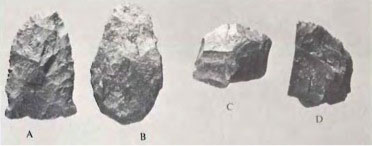
Some
of the numerous artifacts from Cherry Point
**Index

3. The
Land
Oak Lake is situated on the flat plain of Glacial Lake Souris. At that
time region was probably a transitional area between Parkland and
Prairie vegetative zones.
Prior to large-scale agricultural use, brush fires and the grazing of
huge bison herds kept wooded area to a minimum. Trees were confined to
areas along waterways.
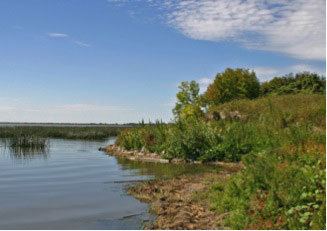 The
marshy shore along Cherry Point
The
marshy shore along Cherry Point
The Lake
Oak Lake has provided a welcome refuge to
many
peoples over the 12000 or so years that humans have inhabited this
land. An abundance of resources including firewood, food and shelter,
would have been available here, making it especially attractive for
habitation during the spring and early summer months.
Archaeological research on this site from 1973 to 1975 indicate that
the McKean Culture used Cherry Point as a seasonal bison kill and
butchering site beginning over 2000 years ago.
The report on the excavation refers to, “the power of the lake as an
attraction to the peoples of Manitoba, both modern and prehistoric”,
and reminds us that over the centuries it has served as “a site for
bison drives, the hunting of game, fishing, a centre of trade and
trapping, a source of lumber for overland travellers, and most
recently, as a summer holiday resort.”
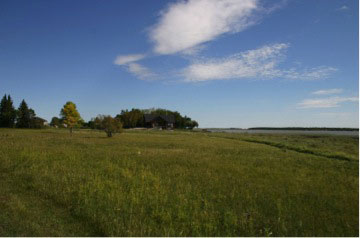 The
site of the series of excavations
that
helped uncover the past use of Cherry Point
The
site of the series of excavations
that
helped uncover the past use of Cherry Point

4. The People
Evidence from the site reveals that peoples
of
every cultural complex known to southwestern Manitoba have occupied
this lakeshore. Artifacts collected here span a range from projectile
points left by the earliest inhabitants, to lead musket balls such as
those used by Meitis bison hunters or fur traders, and on to pop bottle
caps left by holiday campers. Much of the most significant artifacts
however, relate to a group that had migrated northwards from the
central Midwestern United States called the McKean people.
The McKean people, who used the site beginning about 500 BC, likely
sought shelter from the open plains in more forested locales during the
winter months but camped here in the spring and summer to make use of
the resources. Animals living in this region included fox, wolf, mule
deer, prong-horned antelope, modern bison, mountain lion, elk and bear.
The marshy vegetation supported reeds, sedges and meadow grasses. But
it was the bison that they relied upon.
The ancestors of the McKean people are believed to have originated
within the Desert Tradition, centered in the American Great Basin. They
migrated into what is now Alberta and Saskatchewan before eventually
coming east to Manitoba.
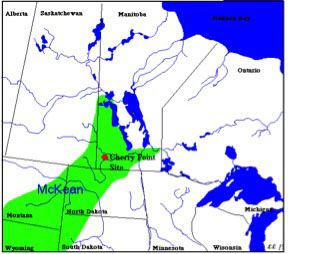 Research
at Cherry Point confirmed that
the
McKean & Oxbow complexes survived in Manitoba long after they had
disappeared in other areas of the plains. The prehistory of the
Northern Plains was shown to be more “complex and dynamic” than
otherwise thought. (Reeves 1970:217)
Research
at Cherry Point confirmed that
the
McKean & Oxbow complexes survived in Manitoba long after they had
disappeared in other areas of the plains. The prehistory of the
Northern Plains was shown to be more “complex and dynamic” than
otherwise thought. (Reeves 1970:217)
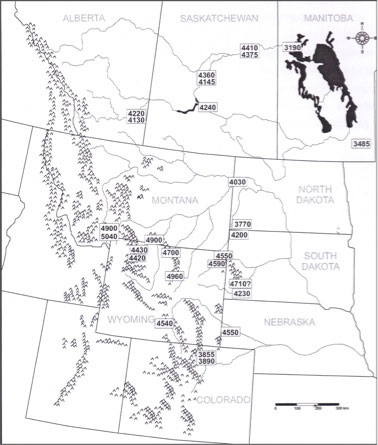 Webster,
p96: McKean Sites with radiocarbon dates (BP (Before present)
Webster,
p96: McKean Sites with radiocarbon dates (BP (Before present)
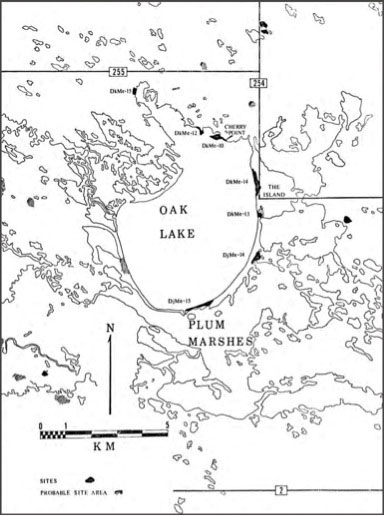
Several other significant sites
exist in the
immediate
area.
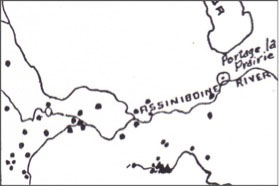 McKean
Sites in Southwestern Mb. Syms,
1969
McKean
Sites in Southwestern Mb. Syms,
1969
Origins and Adaptation
The Bighorn Basin and Yellowstone headwaters are the likely homeland of
the McKean People. They appear in Canada about 500 years after they
have been identified elsewhere.
McKean
and Oxbow sites
overlap. Separate Oxbow and McKean sites found
adjacent to one another indicate that the groups co-habited and shared
a similar subsistence base. The McKean tradition is particularly well
represented in Manitoba at the Cherry Point site at Oak Lake.
People who produced McKean projectile points were highly adaptable, and
had developed strategies to exploit resources in a variety of settings
such as the Boreal Forest of Manitoba and the mountain ranges of
Wyoming and Colorado.
The spread of McKean is may be related to changing climatic conditions,
and to increased population pressure within the 'core region'. The
outward expansion of McKean was likely facilitated by the adaptability
of the McKean toolkit and a willingness to utilize a wide variety of
resources. That they co-existed in this region with other
hunter-gatherer societies, some of them seemingly more complex, may
indicate that there was a relative abundance of food – notably the
bison, or that there were adaptations of which we are as yet unaware.

5. Lifestyle
Evidence from this and other sites indicates
that
the McKean people where a highly adaptable culture that developed
strategies to exploit resources in setting ranging rom the Boreal
Forest of Manitoba to the mountains in the western U.S.A.
Sites are found 2500 metres above sea level in mountainous areas, on
the short-grass prairie of Montana, and on the Manitoba Lowlands.
Hunters occupying the Cemetery Point site in eastern Manitoba relied on
the big and small game that the forest provided. At Cherry Point, the
diet was predominantly bison.
The occurrence of grinding stones at earlier McKean sites in Wyoming,
suggests that vegetable foods were ground and used for subsistence in
that region. Earlier McKean sites in Montana and Wyoming show evidence
of pit houses, indicating a more settled lifestyle. No evidence
of either was found at Cherry Point.
The McKean people who moved northwards may have become specialized in
bison hunting and reduced their dependence on vegetable food processing
and their use of grinding implements (Dyck 1983:101). Of course they
took advantage of other available large game, they trapped small
animals, and foraged for seeds and vegetables.
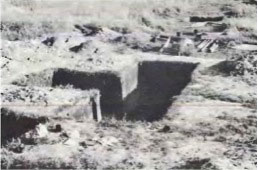 An
excavation in 1975
An
excavation in 1975
But the implication is that they adapted to their surrounding. The
hunter / gatherer lifestyle was the logical choice for the time and
place. In other places, and at other times, other strategies were
required.
Across the northwest they show a preference for locations along large
rivers. The Cherry Point site seems an exception to that, but it was
only a season kill site rather than a year-round settlement.
The use of North Dakota Knife River Flint at Cherry Point indicates
that the inhabitants either had to travel approximately 300 kilometres
south or that they traded with other groups who did travel. All
evidence points to a quite sophisticated technology. They lived a
simple lifestyle based mainly on bison kill, but they were very
efficient at what they did.

6. Harvesting
and Processing
Bison
The stone tools, projectile points (arrowheads) and scrapers found
here, tell stories of how people butchered bison and processed meat and
prepared hides.
The scattered patterns of small bone fragments suggest that bones were
smashed to obtain marrow, which is rich in protein and fat. The
remains of moose, wolf, fox, badger, turtle, fish and elk were also
found indicating that these people subsisted on many other animals in
addition to bison.
There are two stages in the butchering process. Light butchering takes
place at the kill site in advance of transporting the carcasses. Heavy,
non-meaty bones are left behind. The relative absence of skulls and
larger bones at Cherry Point tends to indicate that the kill site may
actually now be covered by the lake and that this campsite was used for
those final stages.
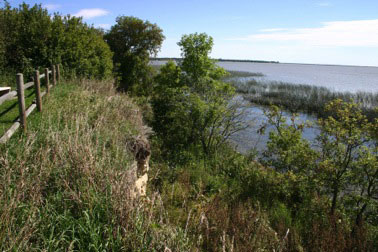 Making
the Kill
Making
the Kill
The wave-cut bank that exists today was quite likely not there when the
McKean people used the site, but the marshy shore below played a role
in the killing process. Animals were likely driven singly or in small
groups along the peninsula and into the lake. The initial dismemberment
of the carcasses took place along the shore. Quarters, heads, and neck
portions of the animals would be hauled further up the shoreline where
excavations have uncovered evidence of butchering activity
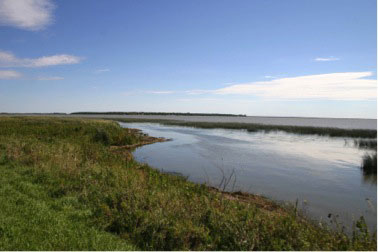 One
excavation site was known as the shoreline
site,
the main excavation site was further uphill.
One
excavation site was known as the shoreline
site,
the main excavation site was further uphill.
The Role of Bone Marrow
An important part of the final stages of the butchering process was the
extracting of marrow used for the making of “bone grease” or “bone
oil”. To do this, first the meat was removed from the bones and they
were left for a day or more to dry. This made it easier to break them,
and improved the flavour. The bones were then smashed into small pieces
and boiled. The grease was then scooped of the top and stored in an
animal bladder. It would keep for up to three years.
Bone grease provided an all-purpose substance. It was full of protein,
fat, and flavour. It was used the way we use butter or lard today. It
could be eaten frozen, used to improve pemmican, and even used as hair
oil.
Breaking
the Bones
Two methods for breaking the bones were identified through an analysis
of the type of fracturing evident. One method involved striking
the middle of a bone at both which is supported at each end. Another
method is to strike a bone directly over the spot where it is
supported. Once the bones were broken, the marrow as extracted with a
smooth stick or a slender bone fragment. The marrow could be stored but
was often eaten fresh, during butchering.Parts of carcasses were likely
hauled up from the shore to be butchered and processed.

7. Interpreting
The
Archaeological Record
Projectile Points
Numerous detachable tips that were used on weapons such as arrows or
spears have been collected. Stone points may be unifacial or bifacial
and may be manufactured by flaking or grinding.
Because of the variety of forms which these weapons may take, and
because of the frequently rigid adherence to a particular style by
members of a culture, projectile points are particularly useful time
markers for the archaeologist.
Three styles of projectile points are associated with the McKean
culture: McKean, Duncan and Hanna. The McKean has a concave base with
no side notching, the Duncan has a similar base but includes
side-notching. The Hannapoint has wider corner notches.
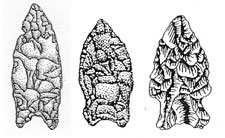 McKean
|
Duncan | Hanna
McKean
|
Duncan | Hanna
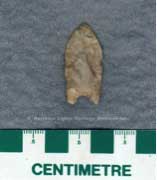 A
sample of the many points collected at Cherry
Point
A
sample of the many points collected at Cherry
Point
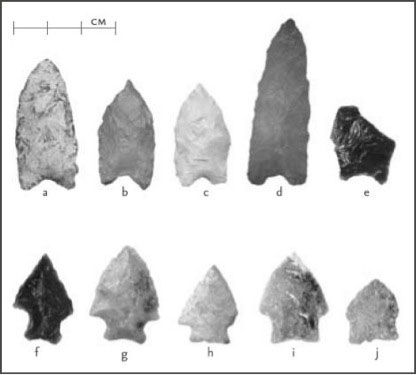 Points
found at the site.
Points
found at the site.
Scrapers
Scrapers were also generally made of stone. They are used to scrape
hides to remove hair and fat, and to soften skin. They may also be used
for cutting skin. The relative scarcity of knives at this site suggests
that little cutting took place.
End scrapers use one or both ends of a blade or flake as the working
edge; and side scrapers utilize one of the long sides of the scraper as
the working edge.
Scrapers are typically formed by chipping the end of a flake of stone
in order to create one sharp side and to keep the rest of the sides
dull to facilitate grasping.
A
sample of the scrapers found at Cherry Point
**Index

8. Summary
The findings at the Cherry Point site are important because they help
archeologists develop a more complete picture of an era in our shared
history. Because the McLean culture was found to have survived and
adapted in Manitoba long after it disappeared in other areas, and
because it developed unique features here, we are more aware of the
complexity of the societies who inhabited what is now our home.
Sources:
Haug, James K.: Final Report #1, The 1974-1975 Excavations at the
Cherry Point Site (DkMe-10). Historic Resources Branch, 1976
Balcomb, Rebecca J.: Final Report #2, Anaylsis of the Faunal Remains
From the Cherry Point Site. Historic Resources Branch, 1976
Pettipas, Leo: Uncovering Early Aboriginal History in Southern Manitoba
Peck, Trevor Richard: Light from Ancient Campfires: Archaeological
Evidence for Native Lifeways on the Northern Plains, Athabaska U Press,
2011
Syms, Leigh: The McKean Complex as a Horizon Marker in Manitoba and on
the Northern Great Plains. U of M. 1969
Webster, Sean Michael: A Re-Evaluation of the McKean Series on the
Northern Plains. Sk Archaeology Society & U of Sask. 2009
A Glossary of Manitoba Prehistoric Archaeology
http://www.umanitoba.ca/faculties/arts/anthropology/manarchnet/appendices/glossary.html
The McKean Complex
1998 Manitoba Archaeological Society
http://www.umanitoba.ca/faculties/arts/anthropology/manarchnet/chronology/archaic/mckean.html
Final Report #1 (PDF)
Haug,
James K.: Final Report #1, The 1974-1975 Excavations at the
Cherry Point Site (DkMe-10). Historic Resources Branch, 1976
Final Report #2
(PDF)
Balcomb, Rebecca J.: Final Report #2, Anaylsis of the Faunal Remains
From the Cherry Point Site. Historic Resources Branch, 1976
|

